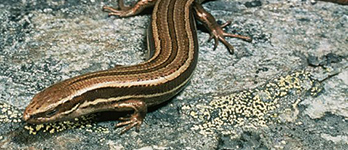Lizards
Nelson’s lizard population is easily missed – these secretive creatures spend much of their time hiding under rocks – but they are a much-valued member of our ecosystems.
The Nelson Green Gecko is of particular importance being endemic to our region. Like birds, lizards are threatened by animal predators and habitat loss. They are also under threat from the plague or rainbow skink, an Australian skink that is spreading into the South Island. Lizards play a critical role in our ecosystems; they pollinate native plants and disperse native plant seeds through eating fruit.
Predation by introduced mammals (e.g. cats, rats, mustelids) is the biggest threat posed to New Zealand lizards - without predators, their populations flourish. Loss and/or fragmentation of habitat through development, habitat degradation by introduced browsing mammals (e.g. pigs, livestock, deer, goats, possums), removal of logs and rocks, and excessive collecting also contribute to on-going declines of lizards over all parts of New Zealand.
Lizards are cold-blooded animals, absorbing heat from the environment. Many lizards bask in the sun to get warm, and if they aren’t warm enough they have difficulty moving. The body temperature that a lizard can achieve has a profound effect on important life-traits: low temperatures can lengthen pregnancy, and can even result in unborn offspring death.
Nelson Green Gecko

The Nelson green gecko is unique to the Nelson Tasman region and is found in open scrubland, such as manuka and kanuka forests. It is hardly ever seen but maybe heard as it has an unusually loud barking noise, in fact, the loudest of all the world’s geckos.
Nelson green gecko young are born live and usually as twins, with sticky feet allowing them to move almost anywhere. They are active during the day, seeking insects to feed on. They are threatened by habitat loss and predation by introduced predators, such as rats, mice and stoats.
Watch the Green Gecko student animations:
Save our native species (Natalia Chaplin)
Nelson Green Gecko (Amanda Ledger)
Image: PhotonewZealand/Rob Tucker.
Northern Grass Skink
 The Northern grass skink (Oligosoma polychrome) is the skink found most often in Nelson backyards - either scuttling amongst the rockery, sunbaking on a warm stone or, sadly, bought in at night by the family cat.
The Northern grass skink (Oligosoma polychrome) is the skink found most often in Nelson backyards - either scuttling amongst the rockery, sunbaking on a warm stone or, sadly, bought in at night by the family cat.
The like to hide in safe crevices and favour tall grass species or rank grass, scrublands and vinelands rather than forests. They love dry, open areas with lots of places to bask and lots of cover to hide under. You can help the skinks in your garden by keeping cats indoors at night and trapping for rats, hedgehogs and other pest species.
The Forest Gecko
 Forest gecko usually live in forested areas, and have with a bright orange/yellow mouth lining. A large variation in colour occurs within and between populations but more typically geckos are grey, green or brown with bold markings of grey, white and sometimes orange and yellow. The tongue colour of forest geckos change with changes in pH. Forest geckos have been found associated with exotic forestry in Northland, Auckland, Spooners Range, Nelson and on the West Coast.
Forest gecko usually live in forested areas, and have with a bright orange/yellow mouth lining. A large variation in colour occurs within and between populations but more typically geckos are grey, green or brown with bold markings of grey, white and sometimes orange and yellow. The tongue colour of forest geckos change with changes in pH. Forest geckos have been found associated with exotic forestry in Northland, Auckland, Spooners Range, Nelson and on the West Coast.
Image - Inaturalist/Jane Godsen
Brown Skink
 Although relatively common on islands in the Marlborough Sounds, there is only one record of Brown skink Oligosoma zelandicum in the Nelson region, at Cable Bay. The skinks live in boulder fields and are threatened by predation by introduced mammals like rats, stoats and mice, and also by coastal inundation as a result of climate change. Oligosoma skinks are both diurnal and nocturnal and and occur in diverse habitats from rocky and sandy shorelines, to forests, to subalpine habitats.
Although relatively common on islands in the Marlborough Sounds, there is only one record of Brown skink Oligosoma zelandicum in the Nelson region, at Cable Bay. The skinks live in boulder fields and are threatened by predation by introduced mammals like rats, stoats and mice, and also by coastal inundation as a result of climate change. Oligosoma skinks are both diurnal and nocturnal and and occur in diverse habitats from rocky and sandy shorelines, to forests, to subalpine habitats.
(Image - Inaturalist/wild-wind)
